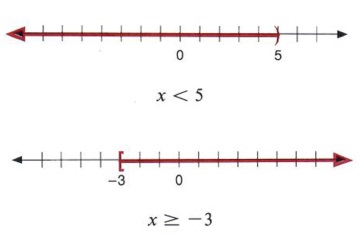~What is an inequality?

~What do the symbols mean?
Well, just like in the last section, I explained each of the symbol meanings. There is the greater than symbol which means the number is greater than another number and there is a symbol that is less than which represents a number is less than another number. Then we have the symbols greater than or equal to and less than or equal to. Those symbols are used for solving equations that have multiple coefficients in the equation. Once we found the value for x, we then make the statement true by following the sign. Let’s say we have x . To determine the equation and to make the statement true, we need to use any number greater than 4 like 5,6,7 and so on.
~How to solve an inequality?
As you can see, the example in this picture is 3x+7 2x-5. This is exactly like linear equations which means legal moves are incorporated to solve this inequality. The difference between the two is that there isn’t an equal sign. Using legal moves, I got x
-12. As I said in the last example, to make this statement true, we need to chose number bigger than -12. We can use 1,2,3 you name it! As long as it’s bigger than -12. Even if there is fractions in the equation, the same rules apply as linear equations. There is one more thing that you need to know. The picture that’s on the right shows an example if there is an negative, then we just flip the equation so that the negative on the coefficient is transferred to the number with any variable. We can then find the proper answer to the equation and the sign stays the same. Remember when we are done, we don’t put an equal sign when we find the value of x, we leave the sign as it is. From these examples, we can take away the fact that inequalities are a lot like linear equations, the only differences are when we divide with negatives and the sign. Although there is one ore difference that stands out that I will be talking about in the next sections.
~How do we graph inequalities?

In the picture on the right, we have two examples. The first one is 5 > x. In the graph, 5 > x is represented by an arrow. The sign points to where the direction of the arrow will be going. The arrow is basically saying that any number to the left of 5 is making the statement 5 > x true. This is usually represented by a white arrow. For the second example it’s a little different. The sign in this is example is greater than or equal to. In order for x to be -3, the arrow needs to be facing towards the rights side because any number that is bigger than -3, makes the statement true. Notice how the arrow is on the -3 has a different sign over it because it can be either greater than or equal to -3. In the first example, since it can’t be equal to 5, it needs to be a smaller number which is why the sign over the number is different from the graph below.
~How to check a solution
There are two ways to check a solution when solving inequalities but before we learn to check our solution, we need an equation. So below, I chose an equation with x being 2. Now that we have an answer, we can check if our equation is right. The picture labeled 1 is the first method to check if our equation is right. Just like in linear equations, in order to check our solution, we need to put our answer which is 2 into the variable spots. Then you figure the question out as if it were to be a bedmas question and if you get the same numbers on both sides that means the question is correct. Now we know that x actually does equal 2, we need to know if the sign is correct. The picture labeled 2 is the second method on how to check an inequality equation. To check our solution, we need to find a number bigger than 2 because to make the statement x is greater than or equal to 2 true, we need to find a bigger number so I chose 3. Now just like the first method, we fill in the variable spots with 3 and if the sign is correct, that means the statement is true therefore making the equation correct. That is how you can check an inequality equation using two methods.
Sources:
https://www.mathsisfun.com/algebra/images/inequality.svg
https://quickmath.com/webMathematica3/quickmath/graphs/inequalities/basic.jsp
The rest of the photos were drawn by myself.





I like your detailed explanations. I also like how you provided great examples and some colorful pictures.